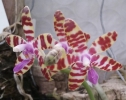|
|
|
|
| Register Yourself at Meyers Conservatory |
To register yourself with the Meyers Conservatory web site, please click the button
below and follow the instructions. You may just make a simple registration with your
email address and a password, but to use the advanced features like the Wish List
you should follow the registration process all the way into the User Information Page
where you can specify plants you are interested in and decide what kind of notifications
you will get.
|
|
|
|
|
| |
Flasks of
Phalaenopsis bastianii 'BAS1' × 'BAS2' |
|
| |
|
|
| |
| Number: |
TN8600 |
| Name: |
Phalaenopsis bastianii 'BAS1' × 'BAS2'
|
| Type: |
outcross (What's that?) |
|
Click to Enlarge

Pod Parent Flower |
Click to Enlarge

Pollen Parent Flowers |
|
|
|
| |
For additional origin/habitat information supplied courtesy of
Charles and Margaret Baker, see further below, near the bottom of this page.
|
Temperatures we attempt to use in the lab & greenhouse:
| For Species: |
|
Spring, Summer, Autumn, Winter: days average 82°F, nights 67°F; best fit is Warm-Intermediate 87-64°F
(Source:
Baker's Web OSC) |
| For Genus: |
|
Spring, Summer, Autumn, Winter: days average 87°F, nights 64°F; best fit is Warm-Intermediate 87-64°F
(
) |
|
About the name...
| Etymology of |
Phalaenopsis |
|
From Greek, "phalaina" moth; "-opsis" appearance.
(Source:
Pridgeon 1992) |
| Pronunciation of |
Phalaenopsis |
|
fail-eh-NOP-sis
(Source:
Pridgeon 1992) |
| Pronunciation of |
Phalaenopsis |
|
fal-eye-NOP-sis
(Source:
Hawkes 1978) |
|
If you would like to direct someone to this web page, please copy and paste this URL into your email:
http://troymeyers.com/d?018600
| Flask Information |
| Availability: |
We have sold all of the flasks for this item. |
| You should: |
Consider getting individual plants or compots instead of a flask.
See if we have plants available in the greenhouse. |
| Yield Estimate: |
239 plants (based on flask surveys done 05/30/2019 through 09/26/2020)
|
| Plantlet Sizes: |
From many flasks 10 - 80 mm plants (based on flask surveys done 05/30/2019 through 08/08/2020)
From one most recently surveyed flask 20 - 70 mm (08/08/2020)
|
|
You might also want to:
|
View the seed assay for this item.
See if we have plants available in the greenhouse.
View items of the same species.
View items of the same genus.
|
| Ordering Information |
| You are not currently logged in. |
|
You must be a registered user and be logged in to reserve a flask or place a notification request. Please log in:
|
|
| Register Yourself at Meyers Conservatory |
To register yourself with the Meyers Conservatory web site, please click the button
below and follow the instructions. You may just make a simple registration with your
email address and a password, but to use the advanced features like the Wish List
you should follow the registration process all the way into the User Information Page
where you can specify plants you are interested in and decide what kind of notifications
you will get.
|
|
|
|
|
|
|
|
| |
The origin/habitat information below is supplied courtesy of Charles and Margaret Baker
The following information is based on the name of the plant provided by the donor, and assumes that the name is correct. If the plant has been misidentified, then the following information may not be correct.
This text is copyrighted by the Bakers and may not be reproduced without permission.
ORIGIN/HABITAT: Philippine Islands. This orchid has been described as
occurring in the Sulu Archipelago, but details of habitat location and
elevation were not reported. Christenson (1998), however, reported that
these plants require intermediate to warm temperatures and regular
watering throughout the year with medium to medium-bright light levels.
Therefore, we have selected climate data accordingly, but the climate
table and resulting cultural suggestions should be used somewhat
cautiously until more precise habitat details are available.
More about this information and the Bakers...
|
|
|
| |
|
|
|